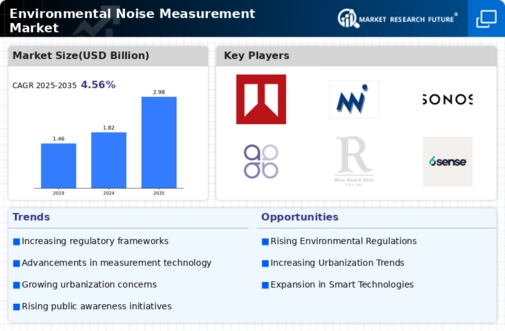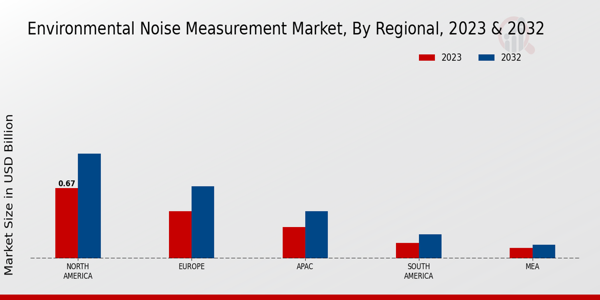Regulatory Compliance
Stringent regulations regarding noise pollution are driving the Global Environmental Noise Measurement Market Industry. Governments worldwide are increasingly enforcing laws aimed at controlling noise levels in residential and commercial areas. For example, the European Union has established directives that mandate noise mapping and action plans in urban areas. These regulations compel industries and municipalities to adopt noise measurement technologies to comply with legal standards. As a result, the market is likely to witness growth, with projections indicating a rise to 2.98 USD Billion by 2035. This regulatory landscape underscores the importance of accurate noise measurement in maintaining public health and environmental integrity.
Increasing Urbanization
The rapid pace of urbanization globally contributes significantly to the Global Environmental Noise Measurement Market Industry. As cities expand, the density of population and infrastructure increases, leading to elevated noise levels. For instance, urban areas are projected to account for over 55 percent of the global population by 2024, intensifying the need for effective noise measurement solutions. This urban growth necessitates the implementation of noise monitoring systems to ensure compliance with environmental regulations and to enhance the quality of life for residents. Consequently, the market is expected to grow, with a valuation of 1.82 USD Billion in 2024, reflecting the urgent demand for noise management in urban settings.
Market Growth Projections
The Global Environmental Noise Measurement Market Industry is projected to experience substantial growth in the coming years. With a valuation of 1.82 USD Billion in 2024, the market is expected to reach 2.98 USD Billion by 2035. This growth trajectory suggests a compound annual growth rate of 4.58% from 2025 to 2035, indicating a robust demand for noise measurement solutions across various sectors. Factors such as urbanization, regulatory compliance, and technological advancements are likely to contribute to this upward trend, reflecting the increasing recognition of noise pollution as a critical environmental issue that requires effective management.
Technological Advancements
Innovations in technology are reshaping the Global Environmental Noise Measurement Market Industry. The advent of smart sensors and IoT-enabled devices allows for real-time monitoring of noise levels, facilitating more effective management strategies. For instance, cities are increasingly deploying smart noise monitoring systems that provide data analytics to inform urban planning. This technological evolution not only enhances the accuracy of noise measurements but also improves the efficiency of data collection processes. As a result, the market is expected to grow at a compound annual growth rate of 4.58% from 2025 to 2035, reflecting the increasing reliance on advanced technologies for environmental noise management.
Public Awareness and Health Concerns
Growing public awareness regarding the adverse effects of noise pollution on health is a key driver for the Global Environmental Noise Measurement Market Industry. Studies have linked excessive noise exposure to various health issues, including stress, sleep disturbances, and cardiovascular diseases. This heightened awareness has prompted communities and governments to prioritize noise reduction initiatives. For example, public campaigns advocating for quieter urban environments have gained traction, leading to increased demand for noise measurement solutions. Consequently, the market is poised for growth as stakeholders seek to address these health concerns through effective noise monitoring and management strategies.
Transportation Infrastructure Development
The expansion of transportation infrastructure is a significant factor influencing the Global Environmental Noise Measurement Market Industry. As new roads, railways, and airports are developed, noise pollution levels tend to rise, necessitating comprehensive noise measurement and management strategies. For example, major infrastructure projects often require environmental impact assessments that include noise studies to mitigate potential disturbances. This trend is expected to drive the market, as stakeholders invest in noise measurement technologies to comply with regulatory requirements and enhance community relations. The ongoing development of transportation networks worldwide underscores the critical need for effective noise management solutions.








